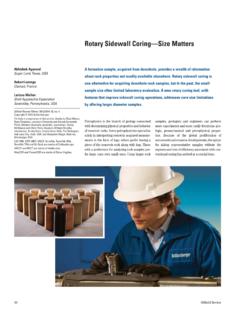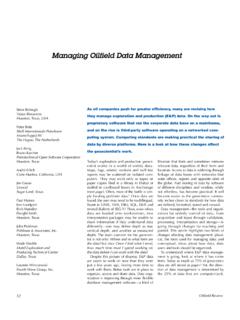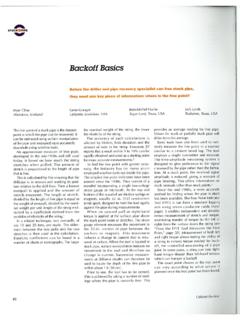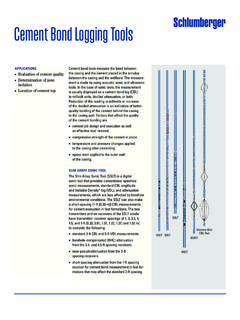Transcription of Carbon ate Rese rvoirs - Schlumberger
1 Mee tinguunniiqquuee cchhaalllleennggeessto maximize recoveryCarbonate ReservoirsProved oil reserves Oil in carbonates 1 Carbonate reservoir s: tthhee ffuuttuurree of world oil and g as productionCarb onat e reservoir s: hheetteerrooggeenneeiittyyat all scales Carbonate reservoi rs: a ccoonnttiinnuuoouuss ffooccuuss248 Although most energy experts agreethat the world s ene rgy resources are adequate to meet this projectedgr ow th, more reserves will be neede d t o delaya peak in produc tio n. This means the petro-leum industry will have to increase recoveryfa ctors significa ntl y from all ty pes of reser-voirs. This incr eas e in perf ormance can beaccelerated at the same time as reducing thetechnical the statistics below it is clear that therelative importance of carbonate re servoirscompared w it h oth er ty pes of reserves willincr ease dramatic ally during the first hal f ofthe 2 1st century.
2 Therefore, so w ill the value of t his market for oilfie ld servic es , there are significant ch allen ges in terms of recover y due t o th e hi ghly complex internal structu re and sp ecifi city of carb onat e rec ent years, demand for energy has surged. Currently, morethan 85% of world energy consumption comes from fossil fuelsand the World Energy Outlook shows that energy demand couldrise by 53% between now and 2030 .Ca rbonate reservo irs: tthhee ffuuttuurree of world oil and g as p ro duction2 MMAARRKKEETT SSIIZZEEMore than 60% of the world s o il an d 40% of the world s gas r eserves are held in carbonat es . The Middle East has 62% of the world s p roved conventional oil reserves ; approximately 70% of these reserves ar e in carbona te re servoirs.
3 The Middle East also has 40% of t he wor ld s pr oved gas reserves ; 90% of these gas reserveslie in carbonate reservoirs . Wor ld Ene rgy Out loo k 2 006 Sc hlumbe rge r M ark et Ana lysis, 20 07 BP Statistical Review 20 073 Proved oil reserves Oil in carbonates TTEECCHHNNOOLLOOGGYY OOPPPPOORRTTUUNNIITTIIEESST echniques that were init ia lly d eve lop ed tocharacteri ze sandstone res erv oirs ar e beingapplie d to carbonate res erv oirs , ye t we k nowthat t hese types of rese rvo irs have diffe rentrequirements. Th e issues of addressing all of the uncertainties an d varia bles incar bon ates present gre at op po rtu nities todev elo p ta ilored technolog umberger is committed t o understandingand addressing the specific challenges andtechnical risks carbonates present.
4 We are atthe fore front of tec hnol ogy development intothe challenges of carbonate reservoirs , an dour contin uous investment in R&D has led to a n umb er of product and service intr oductionsthat are helping our customers optimize andimprove the characterization , the productionand the management of carbonate Distri bution of Carbonate ReservesHow ever , i t is recognized that recovery factors are higher for s ands tone reservoirs than for carbonates . Carbonate reser voir s present a num-ber of specific characteristic s posing complex challenge sin reservoir characterization, production and FFUUNNDDAAMMEENNTTAALLSSC arbonates are sedimentary rocks deposited in marineenvi ronment s with clear, shallow, warm waters a nd ar e mo stl y of biological o rigin.
5 They are made up by frag-ments of marine organisms, skeletons, coral, algae andpreci pitat ion , and consist mostly of calcium carbonate,which is chemically active compared to the sand whi chmakes key diffe ren ce between cla st ic and carbonatero ck s is the distance betwee n the site where the sedimentwas created and where it was deposited. While sand andsilt may travel hundreds of miles down river systemsbef ore de position and lithification, the grains that comprisecarbonate sediments are usu ally deposited very close tothe place where they were c reated. This local depositioncon tribu tes si gnificantly to the h eterogeneity of carbonategr ains. Once carbonate rock is formed, a range of chem-ical and physical processes begins to alter the rock structure changi ng fundamental ch aracteristics such 4 Carb onate rese rvo irs: hheetteerrooggeenneeiittyyat all scales Carbonate rockstypically have acomplex textureand pore networkresulting fromtheir depositionalhistory and exist at allscales in thepores, the grainsand the textures.
6 The average recovery factor the ratio of recoverable oil to the volume of oil or iginally in place for all r eservoirs is about 35%.as porosity and permeability. This is kno wn as diagenesis. At d eposition, carbonate sediments often have very highporosities (35% 75%) but t his decreases sharply as thesediment is altered and buried to reservoir depths. As a r esult, Carbon at e r eservoirs ex hibi t large and a brup tvariations in rock type dis trib utio SSTTRRUUCCTTUURREESSThe porosity of carbonate rocks c an be gr ouped into threety pes: connected porosity, exis ting between the carbonategrains; vugs, which are u nco nn ect ed pores re sultin g fromthe disso lution of calcite b y wa ter d uring diagenesis; andfrac ture poro si ty wh ich is caused by stresses followingdepo sition.
7 Diagenesis can create stylolite structureswhich form horizontal flow barr iers , so me times extendingover kilometers within the reservoir, h aving a dramaticeffect on field performance. F rac tu res ca n be responsible for water breakthrough, gas c oning a nd drilling problemssuch as heavy mud losse s and st uck p ip , these three forms of p oro sity create a very com -plex path for fluids and directly affect well heterogeneity also h as an impact on the res ponse oflogging measurements and t here for e on the determinationof oil in p lace. The complex world of carbonates :From to p to bottom; conne ctedporosity, vugs, fracture porosi AANNDD IITTSS EEFFFFEECCTT OONN FFLLUUIIDD FFLLOOWW In addition to the variations in porosity, wet tab ili ty is a further hetero ge neous characteristic in carbonate s.
8 The great majority of sand st one r ese rvo ir s ar e s tronglywat er- wet. Ho wev er, the aging of Carbon ate ro ck containing water and o il tur ns initially water-wet rocks into mixe d-wet or even o il- wet rocks. This means that oilcan adhere to the surface of carbonate rock and it istherefore harder to produce . Mo st car bon ate reservoirsare believed to have mixed wettab ility o r to be show that in res erv oirs under-going waterflooding only limited amounts of oil can b e recovered fromoil-wet layers be ca use the water tends to flow mainlythr ough the water-wet layers. In fact, recove ry f act ors can be less than 10% .Ch ara cterizing the distri bution of wettability and understanding its eff ects of on fluid flow within a comp lex res ervoir is crucial in estimating the prod uci blereserves and determining production strategies to maximize water is injected in a vertical injector on theleft and produced through a vertical producer on the view: this reservoir is water-wet and the injection front has the usual uniform view: the waterpreferential path is throughthe water-wet layers.
9 Theoil-wet layers are b ypassed,significantly scenario of hetero-geneous wettability distribution requires adapted production strat-egies combined with well-chosen enhanced oilrecovery (EOR) technologies. Montaron, B.: Increasin g Oi l Recovery Factors: A Techni ca lChallenge Ke y to Fu ture Wor ld Ener gy Sup ply, A FTPC onference, Par is, Octob er, 20 Geology, Wettability and Reser voir DynamicsGravity-dominated flow in water-wet reservoirCapil lary-dominated flow in layere d wettabilitySimula tio ns generat ed using ECLIPSE* saturat ed z on esOil satu rated zones8 Schlumberger recognizes the specific challenges of carbonatereservoirs and has a networ k of research laboratories andtechnology centers which is actively inv olved in carbo nateprojects.
10 In t he Middle East, the Dhahran Car bonate ResearchCenter is entirely dedicated to c arbonate research. Significantresearch activity in flow modeling, fracture detection and seismicservices is also taking place in r esearch centers in C ambr idge,Stavanger and Moscow, while our r esearch center in Boston isengaged in geology and pet rop hysics, and our technology centers inClamart and Sugar Land are de velo ping logging-while-drilling (LWD)and stimulation services t ar get in g car bon ate l ong -term commitment to resear ch into carbonates is enablingus to deve lop and introduc e solutions that are improving charac-terization, productivity and rec overy in carbonate res er voir s.








